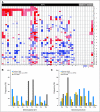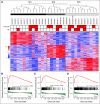Genome-wide analyses identify recurrent amplifications of receptor tyrosine kinases and cell-cycle regulatory genes in diffuse intrinsic pontine glioma
- PMID: 21931021
- PMCID: PMC3209696
- DOI: 10.1200/JCO.2011.35.5677
Genome-wide analyses identify recurrent amplifications of receptor tyrosine kinases and cell-cycle regulatory genes in diffuse intrinsic pontine glioma
Abstract
Purpose: Long-term survival for children with diffuse intrinsic pontine glioma (DIPG) is less than 10%, and new therapeutic targets are urgently required. We evaluated a large cohort of DIPGs to identify recurrent genomic abnormalities and gene expression signatures underlying DIPG.
Patients and methods: Single-nucleotide polymorphism arrays were used to compare the frequencies of genomic copy number abnormalities in 43 DIPGs and eight low-grade brainstem gliomas with data from adult and pediatric (non-DIPG) glioblastomas, and expression profiles were evaluated using gene expression arrays for 27 DIPGs, six low-grade brainstem gliomas, and 66 nonbrainstem low-grade gliomas.
Results: Frequencies of specific large-scale and focal imbalances varied significantly between DIPGs and nonbrainstem pediatric glioblastomas. Focal amplifications of genes within the receptor tyrosine kinase-Ras-phosphoinositide 3-kinase signaling pathway were found in 47% of DIPGs, the most common of which involved PDGFRA and MET. Thirty percent of DIPGs contained focal amplifications of cell-cycle regulatory genes controlling retinoblastoma protein (RB) phosphorylation, and 21% had concurrent amplification of genes from both pathways. Some tumors showed heterogeneity in amplification patterns. DIPGs showed distinct gene expression signatures related to developmental processes compared with nonbrainstem pediatric high-grade gliomas, whereas expression signatures of low-grade brainstem and nonbrainstem gliomas were similar.
Conclusion: DIPGs comprise a molecularly related but distinct subgroup of pediatric gliomas. Genomic studies suggest that targeted inhibition of receptor tyrosine kinases and RB regulatory proteins may be useful therapies for DIPG.
Conflict of interest statement
Authors' disclosures of potential conflicts of interest and author contributions are found at the end of this article.
Figures




Comment in
-
Molecular genetic approaches and potential new therapeutic strategies for pediatric diffuse intrinsic pontine glioma.J Clin Oncol. 2011 Oct 20;29(30):3956-7. doi: 10.1200/JCO.2011.37.8661. Epub 2011 Sep 19. J Clin Oncol. 2011. PMID: 21931033 No abstract available.
References
-
- Broniscer A, Gajjar A. Supratentorial high-grade astrocytoma and diffuse brainstem glioma: Two challenges for the pediatric oncologist. Oncologist. 2004;9:197–206. - PubMed
-
- Hargrave D, Bartels U, Bouffet E. Diffuse brainstem glioma in children: Critical review of clinical trials. Lancet Oncol. 2006;7:241–248. - PubMed
-
- Roujeau T, Machado G, Garnett MR, et al. Stereotactic biopsy of diffuse pontine lesions inchildren. J Neurosurg. 2007;107:1–4. - PubMed
Publication types
MeSH terms
Substances
Grants and funding
LinkOut - more resources
Full Text Sources
Other Literature Sources
Molecular Biology Databases
Miscellaneous

